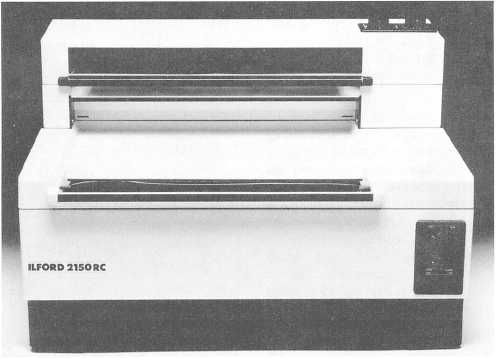Courtesy of Ilford Photo
302.307X
Figure 11-6.–Ilford 2150 black-and-white paper processor.
temperature. The prints should be dry in 10 to 15
minutes.
In the Navy today, most imaging facilities process
prints through automatic processors (fig. 11-6). It is
important for you to know how to process
black-and-white prints in trays, because not all of the
small facilities have automatic machines. Like all
machines, automatic processors breakdown and require
maintenance periodically.
When processing photographic prints through an
automatic processor, you feed the unprocessed print into
the machine; and within seconds, it exits the processor
washed and dried. Your hands never get wet, and you
can process a large number of prints rapidly. The two
most common black-and-white print processors used in
the Navy are manufactured by Ilford and Kodak.
When contact printing an entire roll of negatives
that are not consistent in exposure, it is necessary for
you to make more than one proof sheet from the same
set of negatives. Each sheet of paper should be exposed
to print some of the negatives correctly on that roll. The
result is a composite proof sheet where all the frames
are readable. After all, a proof sheet is a tool to select
the best frames for enlargement and delivery to the
requester. The proof sheets can be stapled together for
filing. This is why, as a photographer, you should strive
to expose each and every photograph correctly. Amateur
snapshooters can shoot film with wildly varying
exposures; professional photographers cannot. A good
print shows detail in both the highlights and the
shadows.
Cleanliness is essential to produce good prints
consistently. Keep a supply of clean towels handy, and
wash and dry your hands before handling paper and
negatives. Clean, dry fingers should touch only the
extreme edges of the emulsion side of these papers.
When developer is on your hands, dark fingerprints
show on the print. Fixer produces white fingerprints.
These fingerprints develop and show clearly on the
finished prints. You should use two print tongs–one for
the developer and one for the stop and fixing baths.
It is not economical to use minimum quantities of
developer. Small quantities oxidize (turn brown) very
quickly. Oxidized solutions cannot produce clean,
brilliant, pleasing photographs.
PROJECTION PRINTING
Projection printing is the process of making positive
prints by projecting the negative image onto
photosensitive paper. The projected image may be
11-8


